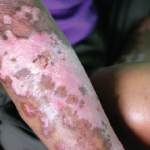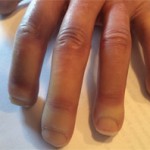One discovery researchers are recently focusing on is the concept that at birth, small amounts of fetal cells pass through the placenta into the maternal circulation, and that these cells, in some women, may persist for decades in the maternal circulation. Conversely, there may be a mixing of maternal cells in the fetal circulation (perhaps explaining why males or nulliparous women develop scleroderma, albeit at a lower frequency). When skin biopsies are performed in scleroderma patients, these fetal cells (or in the case of men—maternal cells) are seen more frequently and in higher numbers than in patients without scleroderma.6 Potentially, then, scleroderma may be a chronic immunologic reaction to “non-self” cells—an unsuccessful attempt by the immune system to recognize and eliminate the cells of the previous generation.
Back to the Patient
After clinic hours, I located Dr. Indura in the Intensive Care Unit on the 12th floor of Presbyterian University Hospital. An arterial line had been inserted into the radial artery at the right wrist, and a monitor overhead gave a continuous reading of her blood pressures. The pressures were elevated even higher than the morning readings: 168/98, and I was surprised she was requiring oxygen. She was asleep, nestled in a matrix of IV lines, nasal oxygen and a Foley catheter draining from her bladder. Her primary nurse put her finger up to her mouth as I entered the room. She closed the drapes, and we moved outside the room.
“She’s had a difficult morning,” her nurse began. “The medical student, resident and medicine attending took a long time to settle her in, and she just dozed off. They had a horrendous time getting the arterial line in. Just couldn’t hit it. They finally had to call one of the anesthesia residents, and even she had some trouble threading it in. And you are?”
“Chuck Radis. I’m the new rheumatology fellow.”
“We don’t see you guys down here very often.” She glanced back at the curtain. “Her skin looks awful. Have you seen her fingers? They look like they’re going to fall off.”
“So did the primary service start her on captopril for the hypertension?” I asked.
“Let me see.” She scanned the med list. “Captopril. Captopril. Okay, here it is, 25 mg twice daily. I gave her the first dose about an hour ago. The med resident wants to take it slow. Did you see her creatinine of 2.5? Poor thing, she’s so young. Medicine is worried the captopril might bottom out her blood pressure.”



